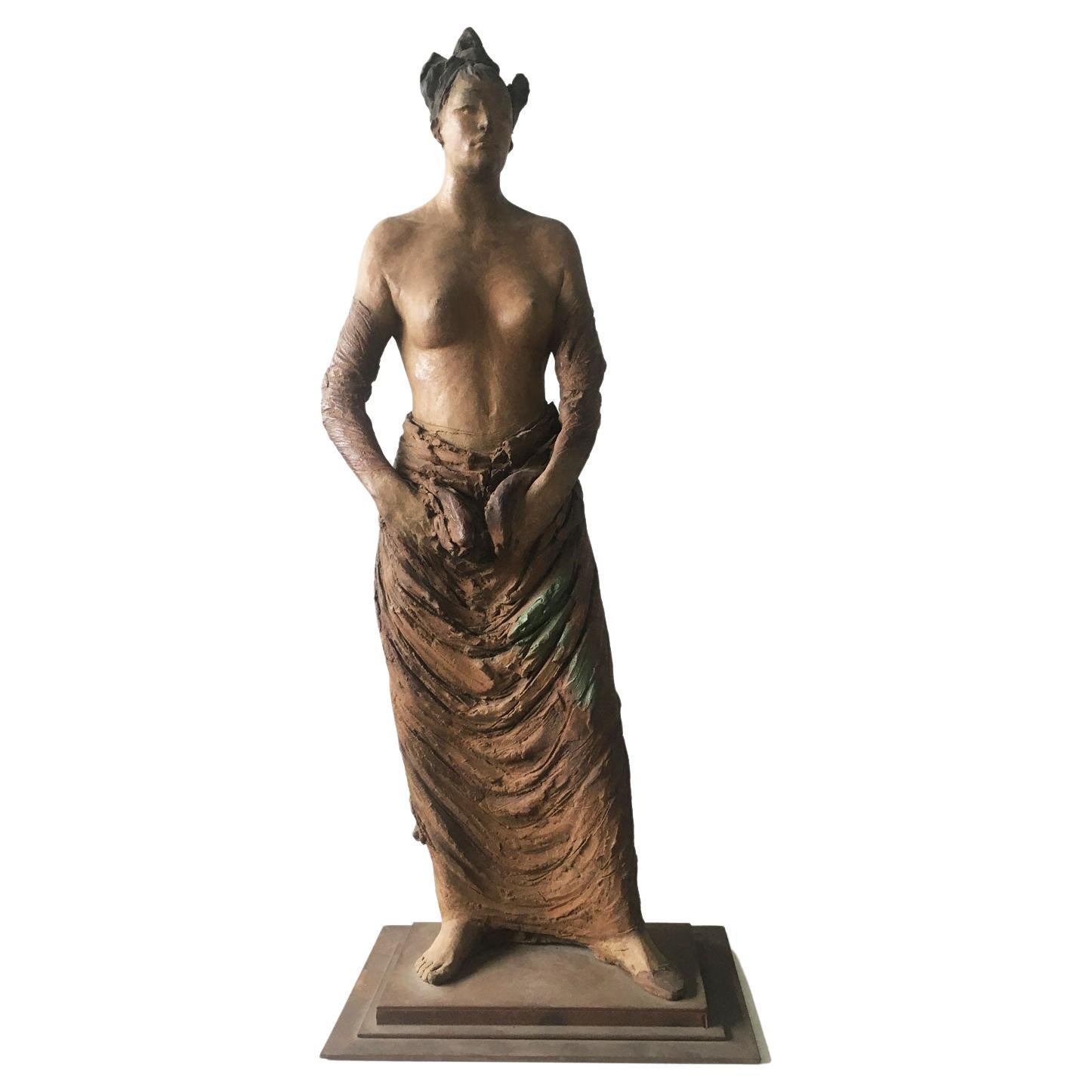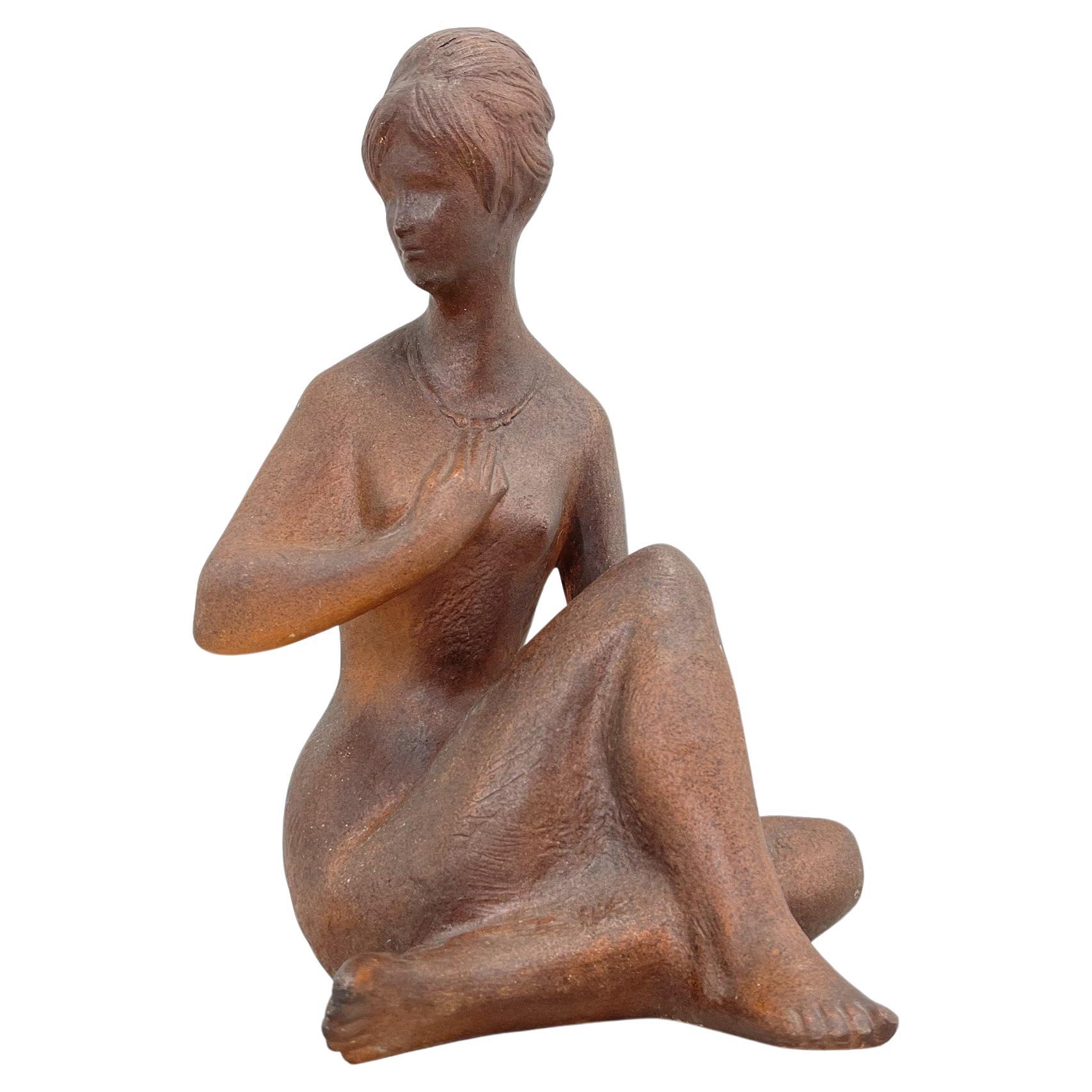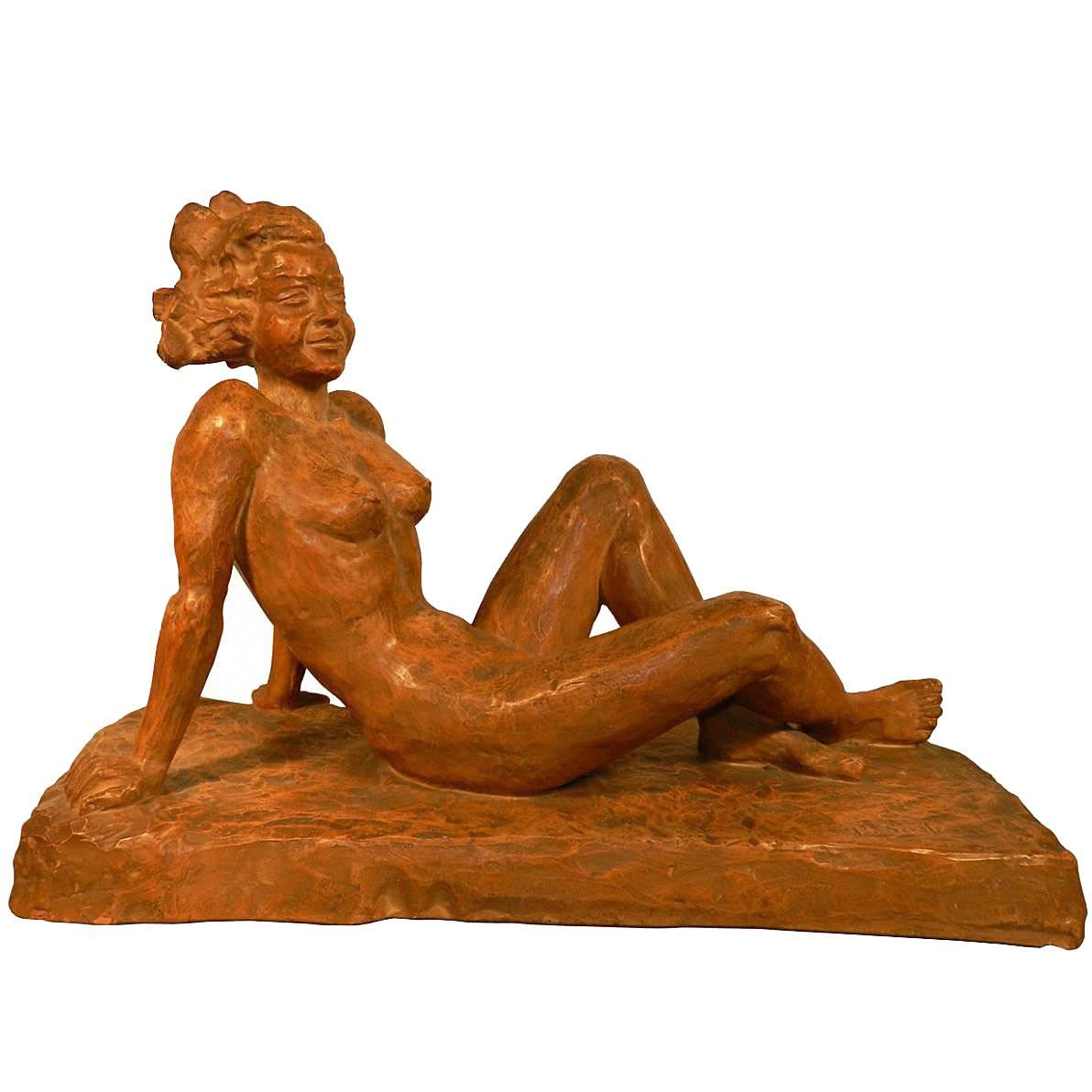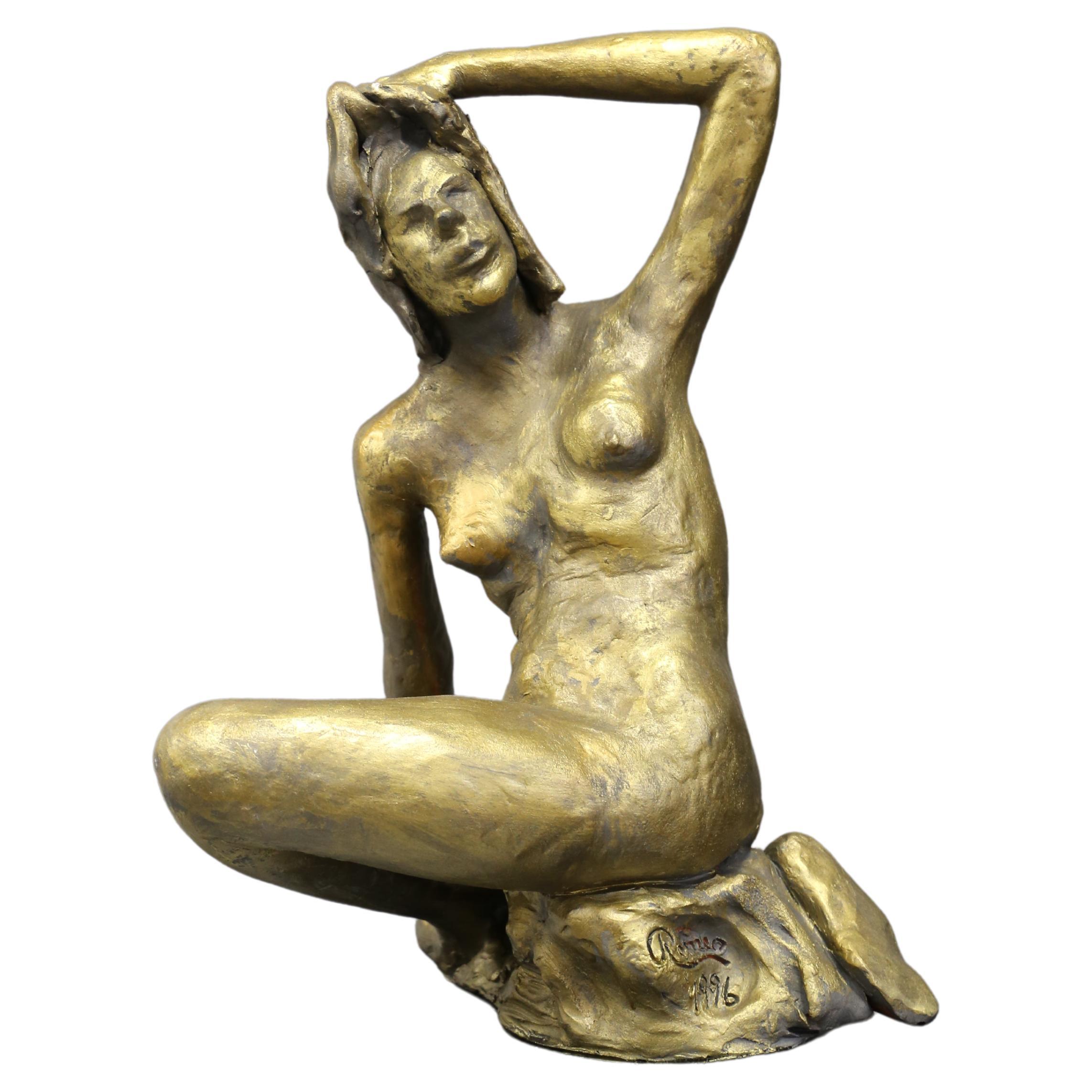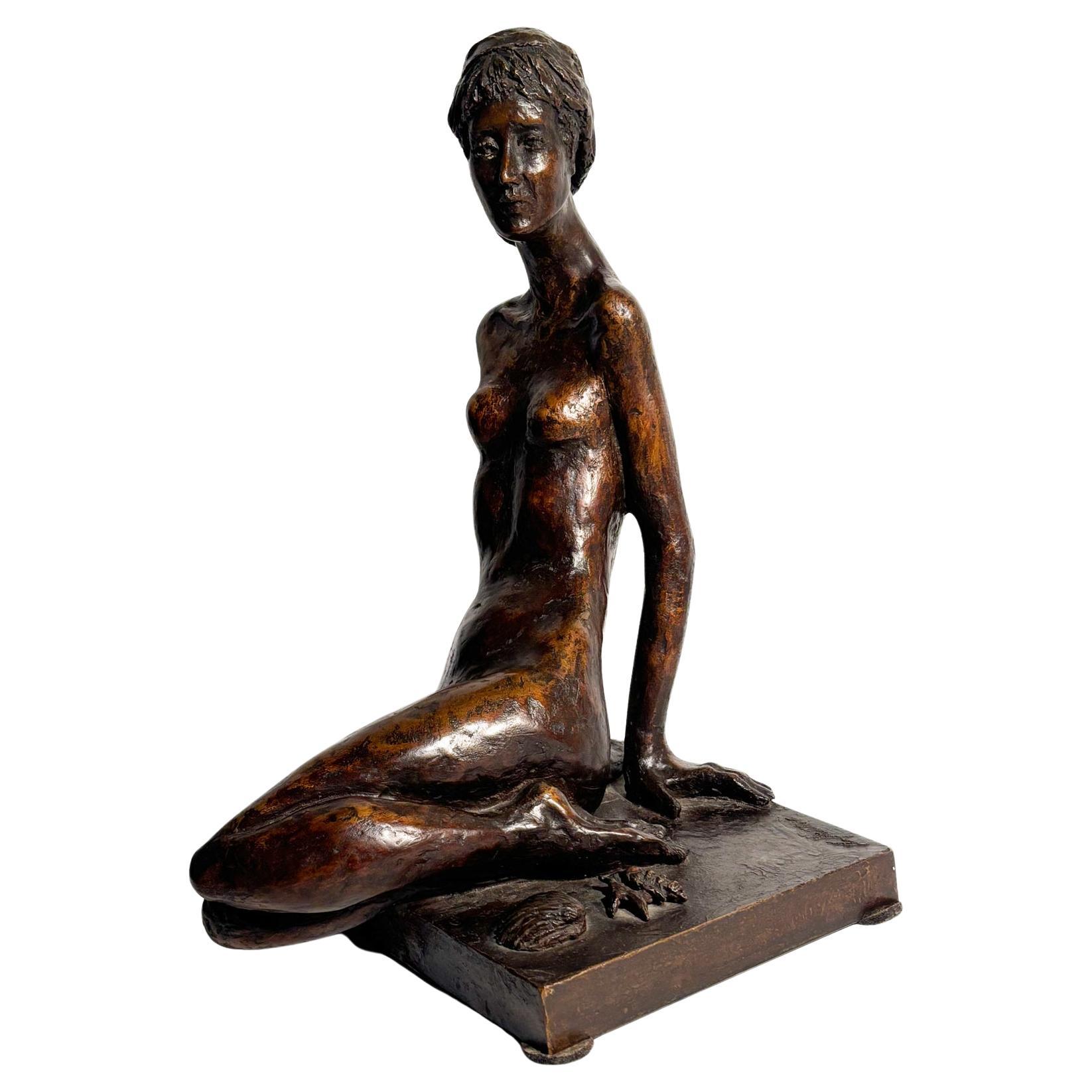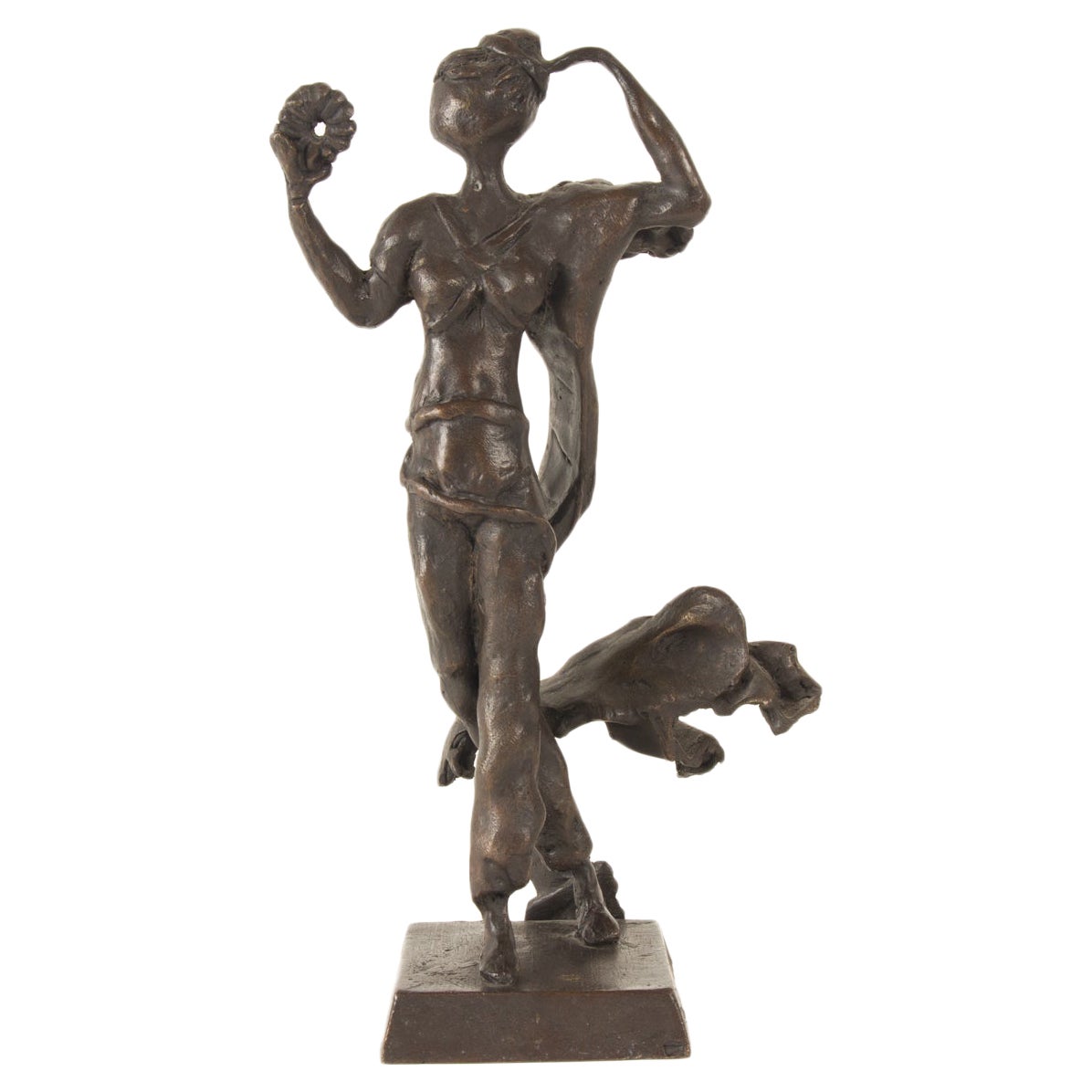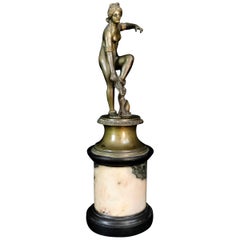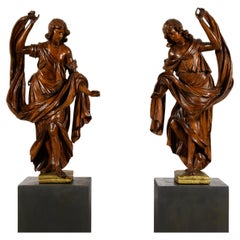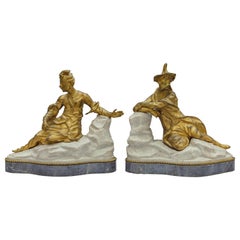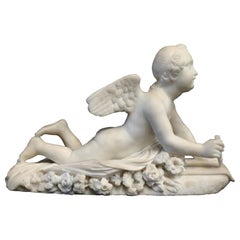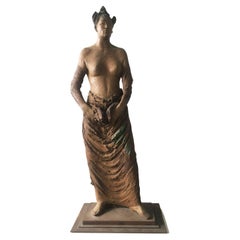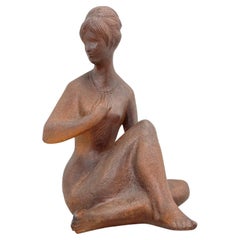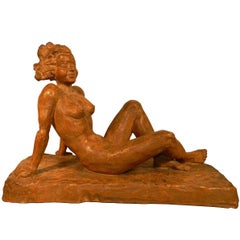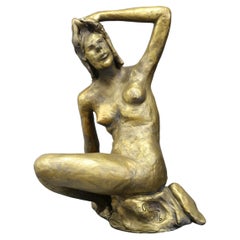Items Similar to 20th Century, Italian Sculpture by Helen König Scavini, Lenci Manufactory
Want more images or videos?
Request additional images or videos from the seller
1 of 19
20th Century, Italian Sculpture by Helen König Scavini, Lenci Manufactory
$48,016.63
$64,022.1725% Off
£35,935.26
£47,913.6825% Off
€40,500
€54,00025% Off
CA$66,243.11
CA$88,324.1525% Off
A$73,665.09
A$98,220.1225% Off
CHF 38,690.50
CHF 51,587.3325% Off
MX$900,629.66
MX$1,200,839.5525% Off
NOK 482,120.73
NOK 642,827.6425% Off
SEK 454,509.63
SEK 606,012.8525% Off
DKK 308,306.11
DKK 411,074.8225% Off
About the Item
Helen König Scavini, Lenci manufactory
"Nude of Woman", e.g. 1927-1936
Signed under the base "Lenci/Italy"
Glazed terracotta
sizes: H 70 cm x W front 83 cm (W back 55 cm) x D 55 cm
The important sculpture, realized in glazed terracotta, is by the famous Lenci Manufactory of Turin (Italy) on model by Helen König Scavini. Of remarkable dimensions, it represents a naked woman, covered of a single cloth to life, sitting with the legs flexed asymmetrically while it supports on the arms with the hands leaned to the plan. The woman has a hieratic expression, big eyebrow arches under which the ethereal eyes are half-closed; the open lips hide a hint of a smile. The loose hair is turned back with big waves on both the head and along the back. The staining of the glazing is on the tones of musky green, which contributes to confer to this woman the appearance of a nymph or a mythological figure.
Below the base is found, hand painted, the trademark of the manufacture "Lenci, ITALY". The brand Lenci was registered in Turin on 23 April 1919, sanctioning an activity undertaken some time before by Helen König, wife of the commercial agent Enrico Scavini. The origin of the word Lenci is still controversial today; the earliest bibliography says it derived from a endearment of Elena (Elenchen, as her father called her and that she, stunned him, pronounced Lenci) while the most recent one considers the acrostic Ludus Est Nobis Costanter Industria, perhaps invented by Ugo Ojetti or built as divertissement by the poet Ignazio Vacchetti (Alias Fantasio) on the endearment of Elena. The Lenci manufactory becomes a meeting point for artists and a forge of ideas for the development and realization of dolls and puppets, children’s furniture, and later also artistic ceramics. The first artists to take an active part in the enterprise were Giovanni Riva and Sandro Vacchetti, soon joined by other great names. The success of these felt dolls earned numerous awards to the Lenci Company during the international exhibitions in Zurich, Paris, Rome or Milan. However, the originality of Lenci’s creations was soon put to the test by numerous imitations. To cope with this type of competition, Lenci began to produce artistic ceramics, whose activity began in 1927. The ceramic figures became perhaps even more famous than the dolls in cloth. The subjects ranged from the famous "nudini", the chic little ladies and emancipated women, from fantasy characters to animals, from religious images to the most disparate vases and much more.
Many artists collaborated in the realization of the models, among which it is worth mentioning the already mentioned Sandro Vacchetti, artistic director of Lenci from 1922-1934, the same Elena König Scavini, Cläre Burchart, Lino berzoini, Giovanni Riva, Giovanni Ronzan, Deabate Theonesto, Giovanni Pietro Spertini, Marcello Dudovich, Gigi Chessa, Mario Pompei, Nillo Beltrami, Mario Sturani, Giulio Da Milano, Giovanni Grande, Ines Grande, Claudia Formica, Luigi Borione, Camillo Ghigo, Giuseppe Porcheddu, Gino Levi-Montalcini, Abele Jacopi. The magazines of the time bear witness to the artistic value of the ceramics Lenci: from the magazine "Domus" to "Casa Bella", the constant publication of the ceramics Lenci demonstrates the will to impose itself on a select public, cultured and refined. Participation in the exhibitions of the time, from the International Exhibition of Decorative Arts held in Monza in 1923, to the International Exhibition of Paris in 1925, to the National Exhibition in 1928 in Turin, will determine its success. In December 1929 at the Pesaro Gallery in Milan 95 works were exhibited, accompanied by a long presentation by the art critic Ugo Ojetti and testifying to the activity of almost all the artists working for the excavations. Followed the presence of Lenci at the IV International Exhibition of Decorative and Modern Industrial Art in Monza in 1930, which gathered a dizzying positive judgment.
The great appreciation of the critics and the attention of the specialized magazines did not save the Lenci from the crisis of the international markets. In 1933 some shares were sold to the Garella family and in 1934 Sandro Vacchetti left the artistic direction of the factory to found his own, Essevi. He was succeeded by Mario Sturani, who remained until 1964, when the production of ceramics stopped. In 1937 the Garella acquired the entirety of the shares of the Lenci maintaining the artistic direction under Elena König, who left the post in 1941, after the death of her husband (1939). In 1992 Lenci Srl was sold to two new companies: the production sector (machinery and equipment in general) was transferred to Bambole Italiane Srl, which went bankrupt in 2002, while the trademarks and patents were sold to WestBay servicos and investimentos in Madeira (Portugal) which today continues its activity regularly.
Today the historical ceramics and dolls by Lenci are sought-after collectibles exhibited in museums all-over the world. With the Lenci in Turin happened what in the same years was manifested in the Danish figurative porcelain and the Viennese ceramics of the Wiener Werkstaette: the attempt, perfectly successful, was to produce pottery that had behind it the design of an artist. The ceramic work therefore became a work of art for its own sake, influenced by the artistic and cultural currents of the time.
The machining processes inside the lenses are complex and of great refinement. The designs of the ceramics are generally watercolor, tempera or pastel drawings. For the realization of ceramics the methods varied according to the artist. A model in clay was made and then entrusted to the trainer to obtain a negative matrix. From the matrix were obtained few copies of prototypes then decorated under and over the glaze by the most experienced painters under the control of the authors of the model. Based on the success of these first specimens it was decided whether to put the object in production. The processing of plaster was the starting point for production, which could also stop at that stage. The assignment of the model number to the plaster is a sure index of the putting in production of the same one: it gave the physical collocation of the gesso same in the room destined to the forming. The ceramic inherited the number of the model assigned to the plaster, proposed to incusso (that is, signatures, acronyms, monograms and numerical combinations) on the single specimens only from a certain moment of the production. Then there were the methods of marking with a brush and of marking with an incubation of the ceramics, connected to different chronological moments. The written Lenci/Italy is among the very first tests, dated between 1927 and 1928.
Of the sculpture under study there is a model in numbered plaster, of smaller dimensions, from which some ceramics are derived, also of similar dimensions to those of the other Lenci porcelain thought as a decorative object.
The inventory allows us to identify the author of the subject, Helen König Scavini, and the title, or "Nude". The numbering of the model, 803, makes it possible to date the model between the years 1931 and 1936, among which were recorded the examples from 421 to 1160.
Our sculpture, being of great dimensions, could be a prototype, a study of Elena to which they followed the successive small productions. It can be assumed that it could have been produced between 1927 (due to the inscription below) and 1936 (for the numbering of the model).
It is also worth noting the existence of another version of the terracotta with the Nuda, gilded, used as an exhibition model for a manufacturer of silk scarves that interprets the design of the historical wrapping paper Lenci, designed by Gigi Chessa. Some information is not mentioned of the sculpture; however, from the image it is possible to deduce that it is of comparable dimensions to the one studied here.
Helen König was born in Turin 28 February 1886 to an Austrian mother and a German father. The family moved to the Piedmontese capital in 1885, but the father died very young leaving the family in serious economic difficulties. Her rich personality, her intellectual liveliness and her particular predisposition for art in her various representations lead her to travel a lot in Europe. In 1907 she graduated as a teacher in Düsseldorf, where she met Clare Burchart, a collaborator for the manufacture of Rosethal porcelain, which brought her closer to the world of modeling. The friend became fundamental in 1928 when she was called to collaborate in Turin to provide her excellent experience. Since 1915 Helen returns to Turin, where she meets and marries Enrico Scavini.
The eclectic personality of Helen, from the Central European education and from the unbridled curiosity, is catalyzing in order to reunite a cenacle of artists progressively involved in the creation of a true and proper artistic world. The success of his dolls becomes planetary decreeing the affirmation of the name Lenci throughout Europe and America. Hers are beautiful little women coming out of the more or less disciplining cinematographic imagination; Helen designs scenes inspired by mythology or devotion, children or animals portrayed in funny and improbable poses.
The style of Helen König Scavini is clearly found in the Nude sculpture. The way in which she interprets the female anatomy, the position of the woman and the features of the face are found in many of her high works. In particular, the head of the woman is very close to the multiple ceramics that Helen draws depicting the nymph calipso. They are female heads haired in a similar way and with the facial features assimilated, though they present some slight variation.
In conclusion, the sculpture in this study represents a significant manifestation of the artistic expressiveness of Helen König Scavini, realized in the central years of her maximum fame, between 1927 and 1936. A work that could be considered a capodopera of the artist, certainly of considerable interest, which is added to the corpus of works by König Scavini and the great Turin-based manufacture.
- Creator:Helen Scavini (Artist),Lenci (Manufacturer)
- Dimensions:Height: 27.56 in (70 cm)Width: 32.68 in (83 cm)Depth: 21.66 in (55 cm)
- Materials and Techniques:Terracotta,Glazed
- Place of Origin:
- Period:
- Date of Manufacture:1927-1936
- Condition:Repaired: There are some cracks in the fingers and legs with old repairs.
- Seller Location:IT
- Reference Number:1stDibs: LU4405218485332
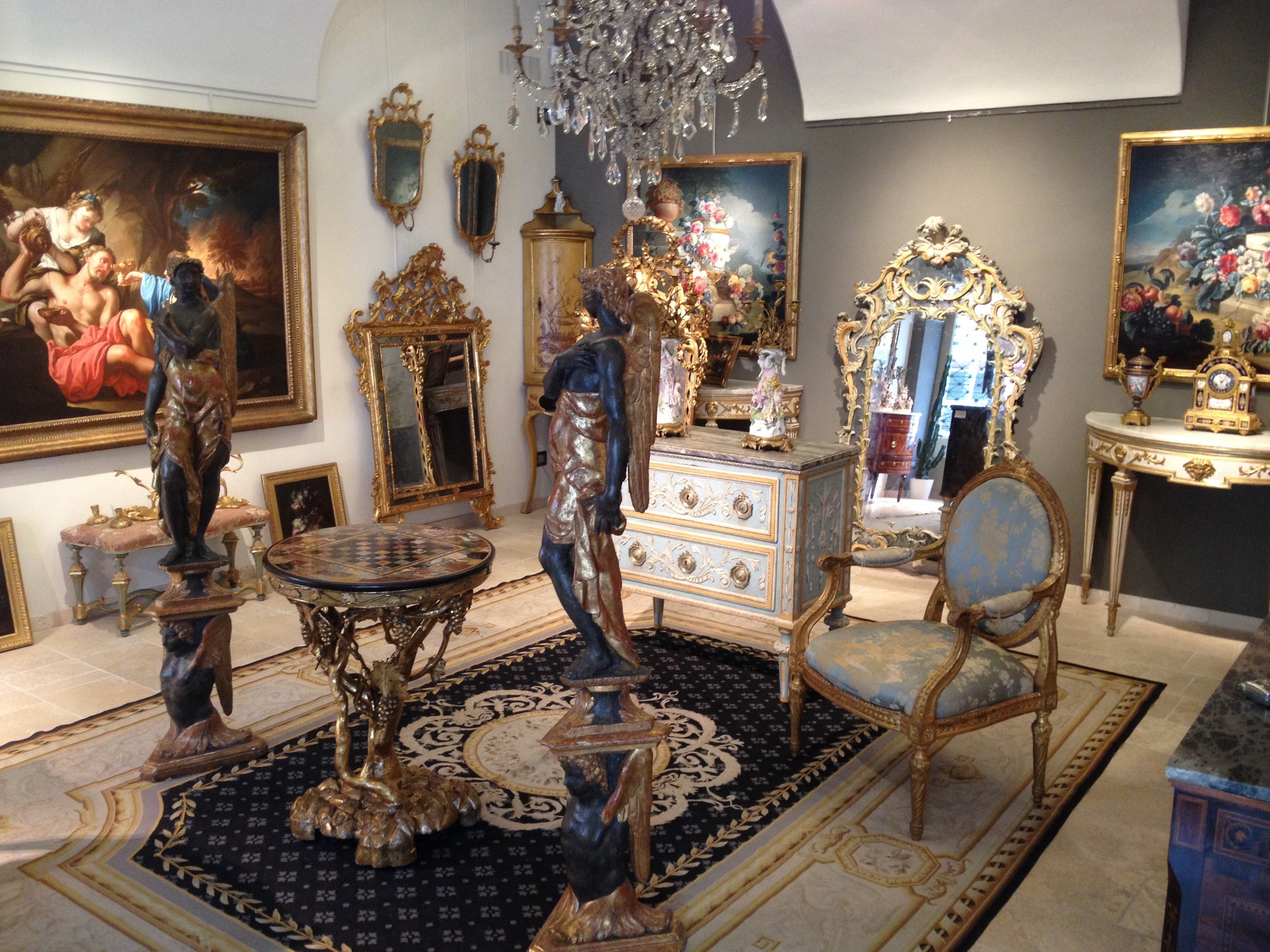
About the Seller
5.0
Platinum Seller
Premium sellers with a 4.7+ rating and 24-hour response times
Established in 1980
1stDibs seller since 2019
56 sales on 1stDibs
Typical response time: <1 hour
- ShippingRetrieving quote...Shipping from: Italy
- Return Policy
Authenticity Guarantee
In the unlikely event there’s an issue with an item’s authenticity, contact us within 1 year for a full refund. DetailsMoney-Back Guarantee
If your item is not as described, is damaged in transit, or does not arrive, contact us within 7 days for a full refund. Details24-Hour Cancellation
You have a 24-hour grace period in which to reconsider your purchase, with no questions asked.Vetted Professional Sellers
Our world-class sellers must adhere to strict standards for service and quality, maintaining the integrity of our listings.Price-Match Guarantee
If you find that a seller listed the same item for a lower price elsewhere, we’ll match it.Trusted Global Delivery
Our best-in-class carrier network provides specialized shipping options worldwide, including custom delivery.More From This Seller
View All18th Century, Italian Bronze Sculpture with Venus Removing Her Sandal
Located in IT
18th Century, Italian Bronze Sculpture with Venus Removing Her Sandal
This bronze sculpture represents Venus as she takes off her sandal. Made in the neoclassical era in Italy, it consists of the bronze sculpture of the Greek goddess Aphrodite, Venus for the Romans. The naked goddess, getting ready for the bath, makes the very human gesture of loosing a sandal.
The left arm is raised, as if to compensate the position while maintaining the balance. Next to her, wrapped around a rocky spur, is a dolphin, an animal iconographically linked to the goddess because of his birth from the foam of the sea. The figure rests on a cylindrical and concave bronze base, with finely chiselled reserves. The bronze element is in turn resting on a africano marble cylinder with black of Belgium marble base.
Venus is one of the major Roman goddesses primarily associated with eros and beauty. It is traditionally understood as the equivalent of the Greek goddess Aphrodite, goddess of beauty, physical and passionate love, among the major deities of Olympus. His birth is due to a dramatic event: Uranus, Heaven, is mutilated by his son Cronus, who punishes him for the wrongs inflicted on his mother. The torn limbs of Uranus fall into the sea and fertilize the foam of the waves of the island of Cyprus. From the waves emerges in all its splendor Aphrodite. Since the 4th century, Aphrodite begins to be represented with characters more human and less heroic. Praxiteles with the 'Aphrodite Cnidia,' for the first time in the history of sculpture, depicts her naked, as she prepares to take a ritual bath.
From the Pressitele’s model descend the Capitoline Venus (Capitoline Museums of Rome) and the Venus de’ Medici (Uffizi Museum of Florence) accompanied by Eros on the back of a dolphin.
This vein also includes a subject frequently attested in the Hellenistic and then Roman Ages, with examples in bronze, marble and terracotta: the Aphrodite who fastens the sandal.
The luck that this type of representation had in the following centuries is demonstrated by the vast number of sculptures that represent it. In this bronze work the goddess resumes the position of Oplontis’s Naked Venus: here Venus holds an apple in her left hand, a reminder of her victory in the beauty contest in which she prevailed over Minerva and Juno by judgment of Paris. In our bronze instead, the hand seems to want to shake the apple, which however has not been molded. Perhaps the bronze is inspired by another work, such as the bronzes kept in the archaeological museum of Padua. Another example is the famous 'Venus in bikini" found in Pompeii, so-called because it depicts the goddess in the same pose, but with the breasts and hips covered by bands painted in gold.
The dolphin depicted next to it could be inspired instead to the Medici Venus...
Category
Antique Late 18th Century Italian Neoclassical Figurative Sculptures
Materials
Marble, Belgian Black Marble, Bronze
17th century, Pair of Italian Baroque Walnut Sculptures
Located in IT
17th century, Pair of Italian Baroque Walnut Sculptures
Measures: H 104 X W 60 X D 30 cm
The pair of sculptures was made in the Venetian area in Italy towards the end of the 17th ce...
Category
Antique Late 17th Century Italian Baroque Figurative Sculptures
Materials
Walnut
18th Century Pair of French Gilt Bronze Sculptures on Marble Base
Located in IT
18th century pair of french gilt bronze sculptures on marble base representing Chinese figures
This particular and lovely pair of sculp...
Category
Antique Mid-18th Century French Louis XV Figurative Sculptures
Materials
Marble, Bronze
19th Century, Italian White Marble Sculpture by Pompeo Marchesi with Cupid, 1840
Located in IT
19th century, Italian white marble sculpture by Pompeo Marchesi with cupid, Italy, 1840
This valuable sculpture, made in white marble in 1840, is a work signed by Pompeo Marchesi....
Category
Antique 1840s Italian Romantic Figurative Sculptures
Materials
Marble
19th Century, French Marble and Gilt Bronze Centerpiece
Located in IT
19th Century, French Marble and Gilt Bronze Centerpiece
This particular centerpiece was made, in white marble and finely chiseled gilded bronze, in France between the end of the eigh...
Category
Antique 19th Century French Louis XVI Figurative Sculptures
Materials
Marble, Bronze
17th Century, Italian Ancient Carved Stone Bust of Roman Emperor
Located in IT
17th century, Italian ancient carved stone bust of Roman Emperor
Measures: H 33 (with base) H 28.5 (sculpture only) x 25 x 7 cm.
The ancient bust, in ...
Category
Antique 17th Century Italian Classical Roman Busts
Materials
Marble, Stone
You May Also Like
2006 Bronze Sculpture by Ugo Riva Innocente Provocazione
Located in Brescia, IT
This is an intense bronze sculpture created by the Italian artist Ugo Riva, in 2006. Lost wax bronze on iron basement.
The title of this artwork is "I...
Category
Late 20th Century Italian Post-Modern Figurative Sculptures
Materials
Bronze
Mid-Century Sculpture Signed by Bohumil Kokrda, 1967
By Jihokera
Located in Praha, CZ
Beautiful patinated ceramic statue by Bohumil Kokrda in 1967 in Czechoslovakia. The statue of a sitting girl is signed by the author. The sculpture is in good vintage condition.
Category
Vintage 1960s Czech Mid-Century Modern Figurative Sculptures
Materials
Ceramic
P.Serste, Large Art Cedo Terracotta Sculpture, Signed
Located in Saint-Ouen, FR
P.Serste, large Art Cedo terracotta. Signed
Category
Mid-20th Century European Art Deco Figurative Sculptures
Materials
Terracotta
Biagio Romeo Woman Sculpture, Signed 1996
By Romeo
Located in Milano, IT
Beautiful bronze and wood sculpture designed in 1996, fine Italian manufacture. SIGNED.
The base is made of lacquered black wood. This form serves as a pedestal for the actual sculpture.
The main body is represented by an entirely nude bronze woman, kneeling.
The woman is seated on a rock, on which the artist's signature is carved.
The woman is represented in a contorted position: in fact, she is seated with one knee on the ground, while her entire weight pivots on the other. With one arm she touches the ground to keep her balance while with the other she touches her head, as if she wanted to be photographed. The woman is completely naked and we can see this from her obvious breasts, but her bottom is also visible.
The woman seems to represent a person who wants to be looked at, proudly showing herself in her nudity. A hymn to female nudity and to the beauty and harmony of the body.
The sculpture is very beautiful and suitable for decorating classy areas.
Bibliography:
Biagio Romeo...
Category
1990s Italian Mid-Century Modern Figurative Sculptures
Materials
Bronze
$758 Sale Price
20% Off
Sculpture of Lady in Bronze by Italian Author 1920s
Located in Milano, MI
Bronze sculpture of nude lady, made by Italian author in the 1920s
Ø cm 26 Ø cm 22 h cm 36
Category
Vintage 1920s Italian Art Nouveau Figurative Sculptures
Materials
Bronze
Bronze Sculpture by Rob Cerneüs
Located in Asaa, DK
Bronze sculpture by Dutch sculptor Rob Cerneüs (1943-2021)
Figurine depicting a woman with flowing garments. Signature on base.
Category
Late 20th Century Dutch Modern Figurative Sculptures
Materials
Bronze
More Ways To Browse
Italy Clay Sculptures
Italian Plaster Sculpture
Life Size Plaster Sculpture
Plaster Sculpture Paris
Nymph Sculpture
Italian Pottery Green Glaze
Lenci Italy
Face Sculpture Female
Porcelain Italian Figures
German Dolls 20th Century
Face Plaster Sculpture
Austrian Terracotta
Nude Porcelain Sculptures
Vintage Doll Heads
Italian Ceramic Vase 1930
Ceramic Animals Life Size
Danish Green Vases Pottery
Vintage 1930 Dolls
